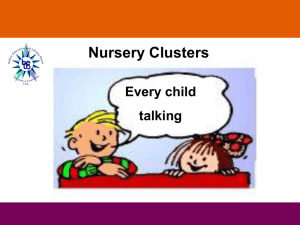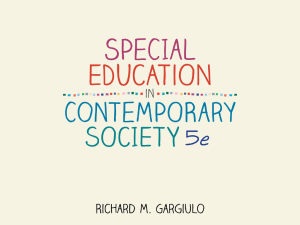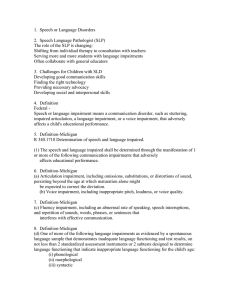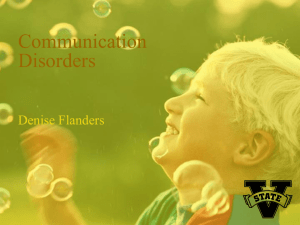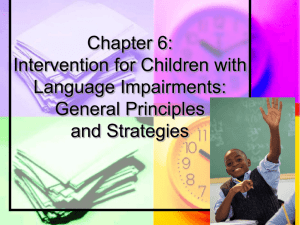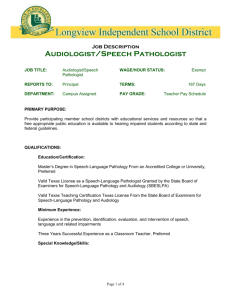Speech/Language Impairment Fact Sheet - West Virginia DOE
advertisement
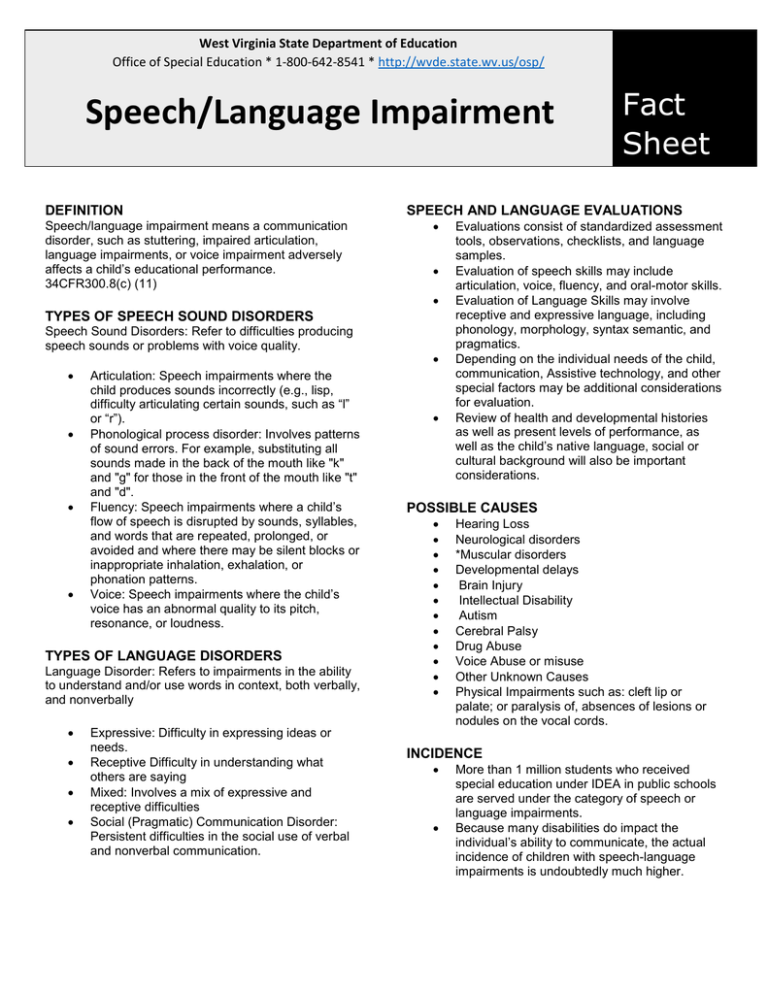
West Virginia State Department of Education Office of Special Education * 1-800-642-8541 * http://wvde.state.wv.us/osp/ Speech/Language Impairment DEFINITION Speech/language impairment means a communication disorder, such as stuttering, impaired articulation, language impairments, or voice impairment adversely affects a child’s educational performance. 34CFR300.8(c) (11) SPEECH AND LANGUAGE EVALUATIONS TYPES OF SPEECH SOUND DISORDERS Speech Sound Disorders: Refer to difficulties producing speech sounds or problems with voice quality. Articulation: Speech impairments where the child produces sounds incorrectly (e.g., lisp, difficulty articulating certain sounds, such as “l” or “r”). Phonological process disorder: Involves patterns of sound errors. For example, substituting all sounds made in the back of the mouth like "k" and "g" for those in the front of the mouth like "t" and "d". Fluency: Speech impairments where a child’s flow of speech is disrupted by sounds, syllables, and words that are repeated, prolonged, or avoided and where there may be silent blocks or inappropriate inhalation, exhalation, or phonation patterns. Voice: Speech impairments where the child’s voice has an abnormal quality to its pitch, resonance, or loudness. TYPES OF LANGUAGE DISORDERS Language Disorder: Refers to impairments in the ability to understand and/or use words in context, both verbally, and nonverbally Expressive: Difficulty in expressing ideas or needs. Receptive Difficulty in understanding what others are saying Mixed: Involves a mix of expressive and receptive difficulties Social (Pragmatic) Communication Disorder: Persistent difficulties in the social use of verbal and nonverbal communication. Fact Sheet Evaluations consist of standardized assessment tools, observations, checklists, and language samples. Evaluation of speech skills may include articulation, voice, fluency, and oral-motor skills. Evaluation of Language Skills may involve receptive and expressive language, including phonology, morphology, syntax semantic, and pragmatics. Depending on the individual needs of the child, communication, Assistive technology, and other special factors may be additional considerations for evaluation. Review of health and developmental histories as well as present levels of performance, as well as the child’s native language, social or cultural background will also be important considerations. POSSIBLE CAUSES Hearing Loss Neurological disorders *Muscular disorders Developmental delays Brain Injury Intellectual Disability Autism Cerebral Palsy Drug Abuse Voice Abuse or misuse Other Unknown Causes Physical Impairments such as: cleft lip or palate; or paralysis of, absences of lesions or nodules on the vocal cords. INCIDENCE More than 1 million students who received special education under IDEA in public schools are served under the category of speech or language impairments. Because many disabilities do impact the individual’s ability to communicate, the actual incidence of children with speech-language impairments is undoubtedly much higher. West Virginia State Department of Education Office of Special Education * 1-800-642-8541 * http://wvde.state.wv.us/osp/ Speech/Language Impairment Speech - Language Impairment is the second largest disability category in West Virginia with nearly 5 percent of enrolled students identified. Approximately 28 percent of students with disabilities in WV receive special education services for speech-language impairments (IDEA 2012 Child Count Data). POSSIBLE SIGNS AND CHARACTERISTICS Speech and/or language skills that are noticeable behind their peers Partial or total loss of the voice Interruptions in the flow or rhythm of speech such as stuttering Articulation or phonological disorders Difficulties in the pitch, volume, or quality of the voice Improper use of words and their meanings Inability to express ideas Inappropriate grammatical patters Reduced vocabulary Inability to follow directions Articulation errors, including omissions, substitutions, or distortions of sounds Possible low self/esteem/self-concept Inadequate social skills Difficulties in language processing Difficulties with vocabulary, sight words, decoding, and comprehension Difficulty writing down thoughts Fluency impairments, including abnormal rate of speaking, speech interruptions, and repetition of sounds, words, phrases, or sentences, which interferes with effective communication Difficulties with abstract ideas Fact Sheet Model Fluent Reading (choral reading, paired reading, etc.) Read, Read, Read Use multiple types of reading strategies (prediction, reader’s theatre, etc.) Make sure that students receive accommodations listed in the IEPs Collaborate with parents and other professionals Do not underestimate the student’s intelligence or physical ability If necessary, use other forms of communication such as sign language, symbols, sign cards, communication boards or electronic modes of communicating Divide academic goals into small units, utilizing the same theme Offer maximal social interaction opportunities Interrelate all tasks in a progressive hierarchy, never moving to a higher step until accomplishing mastery Work at the student’s pace Present only one concept at a time Provide verbal and tangible reinforcements Provide parents with information they can use at home to reinforce the in-school program Use computers in the classroom to present langue units to the entire class Use tactile and visual cues Incorporate vocabulary with unit being taught Provide fun activities that are functional and practical Be aware of the student’s functioning level in the following areas and how they affect academic process: auditory skills, semantics, word recall, syntax, phonology, and pragmatics. TEACHING TIPS/INSTRUCTIONAL STRATEGIES THIS INFORMATION DEVELOPED FROM THE FOLLOWING RESOURCES ASHA/American Speech-Language Hearing There are many powerful things that general and special education teachers can do in class to support the learning of students with speech and language impairments. Always assume competence Incorporate Classroom Materials into Speechlanguage Sessions Provide Visual Input for Visual Leaners Association www.asha.org NICDC/National Institute on Deafness and Other Communication disorders www.nidcd.nih.gov * Cleft Palate Foundation www.cleftline.org Childhood Apraxia of Speech Association of North America/CASANA www.apraxia-kids.org West Virginia State Department of Education Office of Special Education * 1-800-642-8541 * http://wvde.state.wv.us/osp/ Speech/Language Impairment National Stuttering Foundation www.stuttersfa.org National Dissemination Center for Children and Disabilities (NICHCY) www.nichcy.org/disability/specific/ld Fact Sheet

